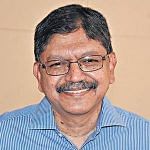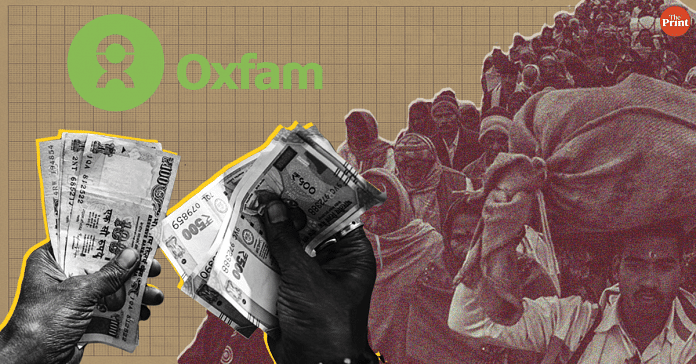In its annual report, Oxfam said that India’s wealthiest got wealthier by 39 per cent as opposed to the bottom half of the population whose wealth increased only by 3 per cent over the last year. The study concluded that the gap between the rich and the poor has only increased. However, the report findings were based only on assets and not income.
ThePrint asks: Oxfam inequality study: Skewed parameters to assess wealth or disbalanced economic growth?
Can’t ignore wealth inequality because there is a causal link between wealth and income inequality
 Abhijit Sen
Abhijit Sen
Former member of the Planning Commission of India, professor of Economics at JNU
For any report attempting to measure anything, what is important is that it is stated at the onset what it is that is being measured. Oxfam did precisely that. At no point did they claim to be measuring income inequality. Their methodology seems to be a fairly sensible way of measuring wealth inequality—provided they are talking about wealth inequality not embedded in the person.
Of course, this leaves out things like education that the individual is pursuing. But besides that, the report is astutely calculating every other aspect of wealth.
It is a well-documented fact that inequality is increasing—both wealth as well as income. It is also true that wealth inequality is far greater than income inequality. But income inequality is increasing primarily because of wealth inequality, so there is a clear causal link between the two. Hence, we cannot dismiss wealth inequality as being unimportant.
There needs to be some sort of taxation of wealth. This isn’t Left literature. This is something even the IMF argues. Taxing the rich has no impact on their incentives and doesn’t lead to any curtailing of their entrepreneurship ability either. This is all the Oxfam is suggesting—that taxing the rich is an effective means of reducing inequality.
The rich are probably getting richer, but the question is if the poor are getting poorer
 Nirupama Soundararajan
Nirupama Soundararajan
Researcher & senior fellow, Pahle India Foundation
Poverty and inequality go hand in hand, but they are not the same. The Oxfam report states that inequality has gone up, but a UNDP report also points out that India has managed to reduce abject poverty by 50 per cent over the last 10 years. Not a small achievement.
I will not debate the methodology or the findings of the Oxfam report. It may well be true that 73 per cent of the wealth created last year went to the top 1 per cent. The rich are probably getting richer, but the question is if the poor are getting poorer. If we were to go by the UNDP report, the answer is no, and credit must be given where due.
Growing inequalities because the rich are getting richer and the rest remain at the same level, is symptomatic of issues that run deeper than mere government policies. Oxfam makes some interesting recommendations, including asking for higher wealth tax, reintroduction of the inheritance tax and doing away with all corporate tax waivers. While these may seem obvious and easy ways to quell inequality, it is a double-edged sword. Higher tax rates have invariably only resulted in pushing wealth out of the country or under the mattresses.
Instead, the government must think differently. Bridging the inequality is not just the responsibility of the government, it is also the moral responsibility of civil society. The 1 per cent of the richest in India are also probably the ones spending the most as part of CSR. Yet, we seem to have not created scalable impact on inequality. Instead of penalising the rich for getting richer, we must find ways for them to pool their resources, to spend CSR money more efficiently together, to create scalable impact.
Picking holes in methodology and not addressing inequality is missing wood for the trees
 Narendar Pani
Narendar Pani
Professor, National Institute of Advanced Studies
The response to the Oxfam report on inequality in India has been, quite predictably, to pick holes in the methodology. Measuring inequality is a complex task and there is no unanimity about the method. The debate on method is used to brush aside very cause for concern.
India’s economic strategy is one that generates inequality. The economic strategy after liberalisation has been so preoccupied with growth that it has little time for the distribution of income built into that growth pattern. The task of addressing these inequalities is then left to the political class, who tries to transfer resources to the affected groups through knee-jerk responses like loan waivers. Thus while the growth generates greater inequality, the anger of the groups that are adversely affected is assuaged through handouts.
When growth slows down this arrangement comes under intense pressure. Slower growth reduces government revenues and hence the ability to offer handouts. At the same time, it also hurts employment levels and the ability of the poor to earn their daily livelihood. To be preoccupied with measurement in such a time is to miss the wood for the trees.
Reports like Oxfam’s can distort the narrative around India’s growth story
 Radhika Pandey
Radhika Pandey
Economist, NIPFP
The Oxfam report presents a gloomy picture of the state of inequality in India. But its findings need to be taken with a pinch of salt. True, India is grappling with inequality but the approach used in the report to assess the state of inequality in India is flawed and shows a limited understanding of the financial sector reforms undertaken in the economy in the last few years.
The metric used to assess inequality is “wealth”. A decline in wealth is the result of an increase in liabilities. This is problematic. With schemes like Mudra and other reforms aimed at easing the credit constraints of the poor, their liabilities are bound to increase. This should not be construed as an indication of decline in wealth of the poor.
Increasing liabilities, such as borrowing to finance consumption and investment, reflect an increase in the standard of the living of the poor. More and frictionless access to credit is a reflection of the success of financial inclusion and should not give a negative impression of rising inequality. A better measure to assess inequality is income levels of people.
Reports like these can distort the narrative around India’s growth story. The reform agenda should continue to focus on greater financial inclusion through access to credit to the poor so that they can come out of poverty and have a better standard of life.
Even if Oxfam is being sensationalist, they are highlighting a very serious problem in India
 Salman Soz
Salman Soz
Congress party member and former member, World Bank
There is no doubt that inequality is rising in India, as it is in many other parts of the world. We can argue about the methodology used by Oxfam in its report, and argue whether all its aspects were right or not. But none of that changes the fact the rising inequality in the country is a matter of serious concern.
Despite the growth, jobs continue to remain stagnant and there just isn’t enough job creation. Until there are new jobs on the market, it is obvious that inequality will only rise. The entrepreneurs will take care of creating jobs, as long as the government stays out of their way and isn’t intrusive. People had high expectations from the Modi government, but their approach has grown extremely statist and centralised in nature. They are now interested in high taxation and all the rhetoric about letting businesses grow has died down.
Instead of getting defensive about the report and remaining in denial about it, we need to find new models of development. The answer is not to attack Oxfam. Even if they are being sensationalist about their report, at least they are drawing attention to a serious problem.
Access to social services should also be taken into account to understand inequality in India
 Deepanshu Mohan
Deepanshu Mohan
Assistant Professor of Economics, OP Jindal Global University
Metrics that are used to study wealth and inequality give rise to conflicting opinions across the world.
The Oxfam 2019 inequality study offers interesting insights into the extent of disproportionate wealth distribution that exists at an aggregate level in India (and abroad) between the rich and poor.
However, while the cited facts in its report do not reflect the change in condition of the middle-income groups over a period of time, in India, the rising concentration of wealth for the top 1 per cent amidst a higher tax structure imbalance (i.e. indirect-tax base) remains troubling.
The indirect-direct tax rate ratio has roughly been around 70:30 with the direct tax to GDP ratio still quite low (around 6-7 per cent), thereby, presenting a strong case for progressive direct taxation to decrease wealth concentration (for the top 1 per cent) and shift away from a higher indirect tax to GDP base (seen to be more regressive in its impact on lower income groups).
At the same time, for India’s burgeoning middle class, measuring inequality from the perspective of income (or wealth) is inadequate. The Oxfam report errs here. In developing countries like India, cost to basic services, including access to basic education, healthcare, affordable housing continues to rise in proportion to rising incomes, which negatively affect the real incomes (purchasing power) of lower-middle income groups over time.
There remains a strong need for analysing drivers and forms of inequality across different income groups, in the context of people’s access to distributive basic social services (education, healthcare and housing). Here, ‘access’ cannot be seen only in terms of a) the physical proximity or distance to a basic public service (school, district hospital etc.), but would also include aspects of b) affordability of a given social service in proportion to the household income of an individual, and c) its social acceptance amidst the lowest classes (and castes) of social groups.
Thus, incorporating the role of distributive Access to Social Services and weighing them in proportion to rising incomes remains critical in understanding inequality, especially in a large middle-income country like India. Additionally, macro efforts to reform the tax structure with a progressive transition towards direct taxes must complement any process to understand and tackle inequality.
By Fatima Khan, journalist at ThePrint. You can follow her on twitter @khanthefatima.



